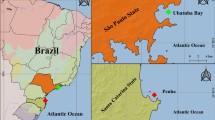Abstract
Acartia and Paracartia species, often known to co-occur, can exhibit complex life cycles, including the production of resting eggs. Studying and understanding their population dynamics is hindered by the inability to identify eggs and early developmental stages using morphological techniques. We have developed a simple molecular technique to distinguish between the three species of the Acartiidae family (Acartia clausi, A. discaudata and Paracartia grani) that co-occur in the Thau lagoon (43°25′N; 03°40′E) in southern France. Direct amplification of a partial region of the mitochondrial cytochrome oxidase I gene by polymerase chain reaction and subsequent restriction fragment length polymorphism results in a unique restriction profile for each species. The technique is capable of determining the identity of individual eggs, including resting eggs retrieved from sediment samples, illustrating its application in facilitating population dynamic studies of this ubiquitous and important member of the zooplankton community.



Similar content being viewed by others
References
Belmonte G (1998) The egg morphology of 7 Acartiidae species: a preliminary survey of the taxonomy of calanoids. J Mar Syst 15:35–39
Blanco-Bercial L, Álvarez-Marqués F (2007) RFLP procedure to discriminate between Clausocalanus Giesbrecht, 1888 (Copepoda, Calanoida) species in the Central Cantabrian Sea. J Exp Mar Biol Ecol 344:73–77
Boyer S, Arzul I, Bonnet D (2012) Some like it hot: Paracartia grani (Copepoda: Calanoida) arrival in the Thau lagoon (South of France- Mediterranean Sea). Marine biodiversity records 5: available at http://dx.doi.org/10.1017/S1755267212000565
Boyer S, Bouvy M, Bonnet D (submitted) What triggers Acartia species egg production in a Mediterranean lagoon? Estuar Coast Shelf Sci
Bucklin A, Bentley M, Franzen S (1998) Distribution and relative abundance of Pseudocalanus moultoni and P. newmani (Copepoda: Calanoida) on Georges Bank using molecular identification of sibling species. Mar Biol 132:97–106
Bucklin A, Guarnieri M, Hill R, Bentley A, Kaartvedt S (1999) Taxonomic and systematic assessment of planktonic copepods using mitochondrial COI sequence variation and competitive, species-specific PCR. Hydrobiologia 401:239–254
Bucklin A, Hopcroft R, Kosobokova K, Nigro L, Ortman B, Jennings R, Sweetman C (2010) DNA barcoding of Arctic Ocean holozooplankton for species identification and recognition. Deep Sea Res Part II Top Stud Oceanogr 57(1–2):40–48
Fatemi M (1938) Les variations saisonnières du plancton de l’Etang de Thau à l’embouchure du canal de Sète. PhD Thesis Université Montpellier 2, France, p 97
Folmer O, Black M, Hoeh W, Lutz R, Vrijenhoek R (1994) DNA primers for amplification of mitochondrial cytochrome c oxidase subunit I from diverse metazoan invertebrates. Mol Mar Biol Biotech 3(5):294–299
Grabbert S, Renz J, Hirche H-J, Bucklin A (2010) Species-specific PCR discrimination of species of the calanoid copepod Pseudocalanus, P. acuspes and P. elongatus, in the Baltic and North Seas. Hydrobiologia 652(1):289–297
Guerrero F, Rodríguez V (1998) Existence and significance of Acartia grani resting eggs (Copepoda: Calanoida) in sediments of a coastal station in the Alboran Sea (SE Spain). J Plankton Res 20(2):305–314
Hill RS, Allen LD, Bucklin A (2001) Multiplexed species-specific PCR protocol to discriminate four N.Atlantic Calanus species, with an mtCOI gene tree for ten Calanus species. Mar Biol 139:279–287
Kasahara S, Uye S, Onbé T (1974) Calanoid copepod eggs in Sea-Bottom Muds. Mar Biol 26:167–171
Lam Haoi T (1985) Evolution saisonnière du zooplancton dans trois sites peu profonds de Thau, une lagune Nord-Méditerranéenne. Hydrobiologia 128:161–174
Lindeque PK, Harris RP, Jones MB, Smerdon GR (1999) Simple molecular method to distinguish the identity of Calanus species (Copepoda: Calanoida) at any developmental stage. Mar Biol 133:91–96
Marcus NH (1990) Calanoid copepod, cladocerans, and rotifer eggs in sea-bottom sediments of northern California coastal waters: identification, occurrence and hatching. Mar Biol 105:413–418
Mauchline J (1998) The biology of calanoid copepods. Adv Mar Biol 33:1–707
Onbé T (1978) Sugar flotation method for sorting the resting eggs of marine cladocerans and copepods from sea-bottom sediment. Bull Jpn Soc Sci Fish 44(12):1411
Tritle D (2006) Activity of Promega Restriction Enzymes in GoTaq® Green and PCR Master Mixes. Promega Corporation Web site. http://www.promega.com/resources/articles/pubhub/enotes/activity-of-promega-restriction-enzymes-in-gotaq-green-and-pcr-master-mixes/ Updated 2006. Accessed 11th Jan 2012
Vincze T, Posfai J, Roberts RJ (2003) NEBcutter: a program to cleave DNA with restriction enzymes. Nucleic Acids Res 31:3688–3691
Webb K, Barnes D, Clark M, Bowden D (2006) DNA barcoding: a molecular tool to identify Antarctic marine larvae. Deep Sea Res Part II-Top Stud Oceanogr 53(8–10):1053–1060
Acknowledgments
The present study was supported by the GELAMED project through a grant allocated by the MEEDDM and the total foundation to D. Bonnet (Programme 189–«Recherche»18902 C).
Author information
Authors and Affiliations
Corresponding author
Additional information
Communicated by C. Riginos.
Rights and permissions
About this article
Cite this article
Lindeque, P.K., Boyer, S. & Bonnet, D. A molecular method for the identification of resting eggs of acartiid copepods in the Thau lagoon, France. Mar Biol 160, 737–742 (2013). https://doi.org/10.1007/s00227-012-2108-1
Received:
Accepted:
Published:
Issue Date:
DOI: https://doi.org/10.1007/s00227-012-2108-1




